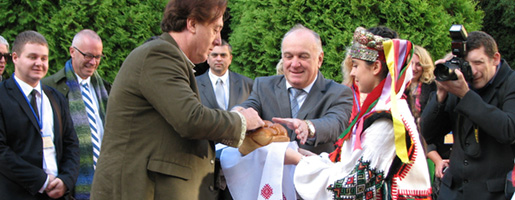
“Carpathians-Appalachians: Human and Community Development in Highland Regions”
September 22-26, 2013 Vasyl Stefanyk Precarpathian National University, Ivano-Frankivsk, Ukraine
After several years of Ukrainians attending Appalachian Studies conferences in the U.S.A. and Americans attending Mountain School conferences in Ukraine, the Institute for Pedagogy of the Precarpathian National University hatched an ambitious vision for a full-blown Carpathian-Appalachian Conference to be held in Ukraine. Appalachian Studies Association members and former Fulbrighters to Ukraine, Donald Davis and Christopher Miller, became Co-Chairs the American planning committee and began to recruit an American delegation. The vision became reality in fall 2013 when seventeen Americans, hundreds of Ukrainians, and several Polish and Slovak scholars participated in the event. From Berea College, Chad Berry, Academic Vice-President and Dean of the Faculty, and Christopher Miller, Associate Director and Curator, Loyal Jones Appalachian Center, attended.
Conference Narrative – Experiences and Learning:
September 21, 2013 – Gathering in Ivano-Frankivsk, Ukraine
Appalachian scholars, teachers, and public humanities professionals gathered in Ivano-Frankivsk, Ukraine for the first dedicated Carpathian-Appalachian conference. They came from six Appalachian states traveling through Kyiv and L’viv.

Appalachian scholars and teachers from North Carolina, Georgia, Tennessee, and West Virginia arrive at the L’viv, Ukraine airport. Additional delegates from Ohio and Kentucky arrived later. Scholars, professors, public humanities practitioners, and one undergraduate student attended the event. A complete list of the American delegation is below.
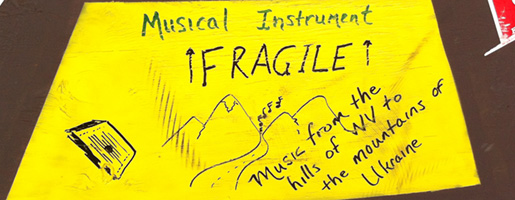
Appalachian hammered dulcimer Master Lynette Swiger brought her instrument and performed during the plenary session. A similar Carpathian instrument is known as the tsymbala [Ukrainian: Цимбала].

A few exhausted delegates spent the evening at a local restaurant meeting young people from the Ivano-Frankivsk English Club. Some delegates brought books with photos of Appalachia. Ukrainians are often surprised and delighted to learn that places like the Carpathians exist in the U.S
September 22, 2013 – Pre-Conference Meeting and Tour
The American delegation met their hosts, toured the Carpathian gateway city of Ivano-Frankivsk, explored its connections to the nearby mountains, visited the mountain tourist City of Yaremcha, and travelled to their accommodations for the in the Town of Mykulychyn.
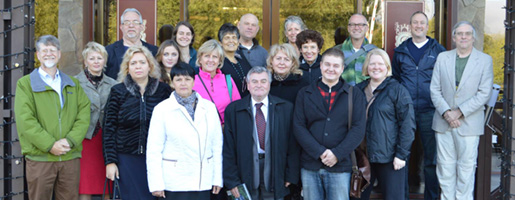
The event began with an initial meeting between the American delegation and officials from the host institution, Vasyl Stefanyk Precarpathian National University. (The delegation from Ohio had not yet arrived.) Photo by Donald Davis
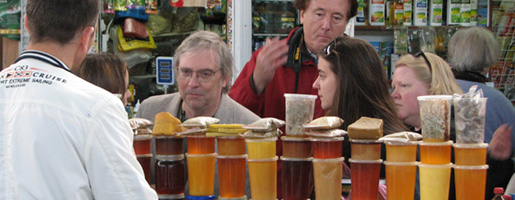
The delegation toured the mountain gateway City of Ivano-Frankivsk. Of special focus was the farmer’s market [Ukrainian: ринок]. Many people from the Carpathians bring natural products to sell, including vegetables, dairy products, honey, sausage, fruit, and mushrooms. Some get up early in the morning to ride a bus into town. We were there during mushroom season and they were abundant. Delegate Paul Arnold had a special interest in Carpathian honey and bees.
September 23, 2013 – Pre-conference Tour of the Carpathians, Verkhovyna Region
Prior to the formal beginning of the conference the delegation toured the Verkhovyna Region of the Carpathians. Fulbright Scholar Donald Davis, then living in Ukraine, arranged the tour with the assistance of local contacts.
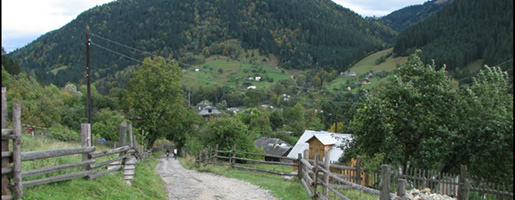
This hillside in Krivorivnya, Ukraine is a typical Carpathian village landscape in the Verkhovyna region.
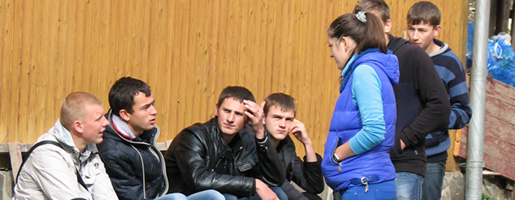
We made a brief stop at the Verkhovyna College of Tourism and Hotel Hospitality. These students were between classes. The college is a branch of PNU. One way PNU is addressing the challenge of providing educational opportunity to mountain students is through small satellite colleges and institutes offering short programs in tourism or pedagogy.
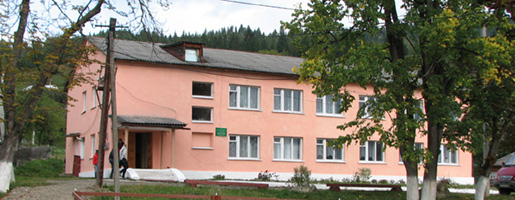
The Verkhovyna College of Tourism and Hotel Hospitality is a modest building on the hillside. It serves perhaps 125 students. Some will transfer to the University in the city for additional degrees.
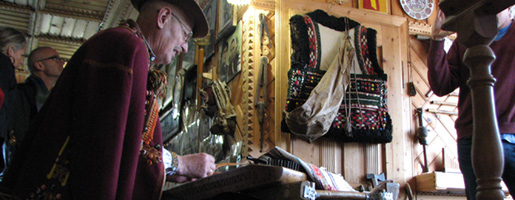
We visited Roman Kumlyk’s Museum of Traditional Folk Instruments and Hutsul Culture. Mr. Kumlyk interpreted many of the traditional Carpathian folk instruments. Here he is playing the tsymbala, nearly the same instrument as the Appalachian hammered dulcimer.
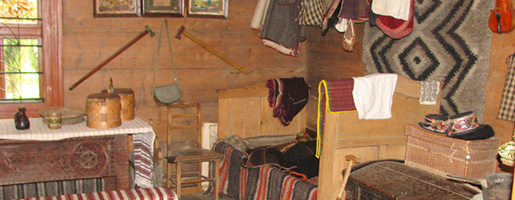
We visit the Ivan Franko Museum. Celebrated Ukrainian poet Ivan Franko spent his summers in this room in Krivorivnya writing about and under the inspiration of the mountains. Many Ukrainian writers wrote about the Carpathians in a phenomenon similar to Appalachia’s “local color” writers.
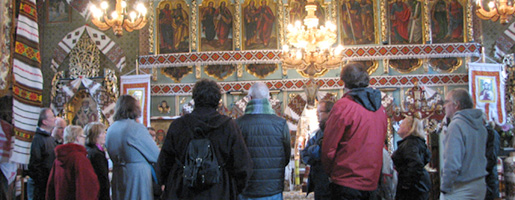
Father Ivan Rubaryk was a gracious host at the Church of Nativity of the Theotokos in the Village of Krivorivnya. He talked about the church, the congregation, his work in the Village, and then offered a prayer for our group. There has been a church on this site for over 400 years.
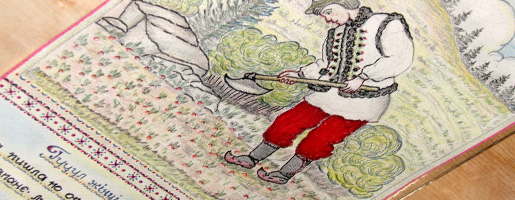
Paraska Plytka-Horytsvit lived almost as a hermit high up a hillside in Krivorivnya. There she spent a lifetime making books on life in the mountains, each hand-written, illustrated, self-bound, and one-of-a-kind. We hiked up to see her small home, now a village museum and literary landmark.
September 24, 2013 – Conference Day 1 – Vasyl Stefanyk Precarpathian National University
The first formal day of the conference started with ceremony and welcome. The plenary session involved hundreds of people from four countries. American delegation contributed formal papers, a musical performance, and an exhibition.
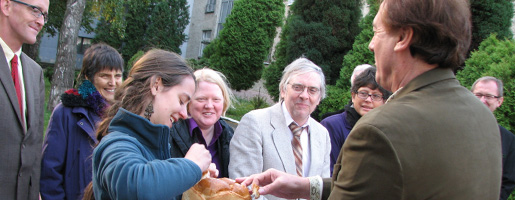
The entire delegation partook of bread and salt offered at the traditional Ukrainian ceremony of welcome.

University Rector (President) Ihor Tsependa welcomed the delegation and received gifts.
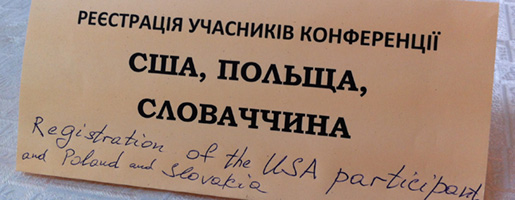
There was a special registration table for the international participants.
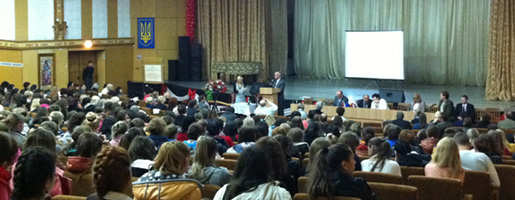
The plenary session at PNU included presentations by Ukrainians, Americans, Poles, and Slovaks. Hundreds of Ukrainian students and faculty were in attendance. Americans Donald Davis, Chad Berry, Lynette Swiger, Judy Byers, and Noel Tenney presented during the plenary.
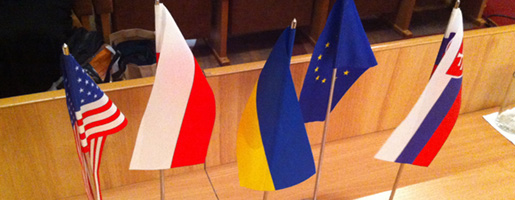
The flags of the U.S.A., Poland, Ukraine, The European Union, and The Slovak Republic (L to R) were on the speakers’ table.
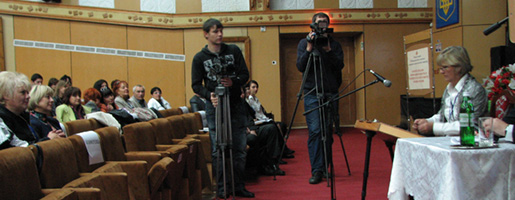
Lynette Swiger’s performance on Appalachian hammered dulcimer was especially well received. Many were surprised to discover that Appalachia had an instrument so similar to the native Carpathian tsymbala. A clip of the performance aired that evening on regional television news. A link to the performance is below.
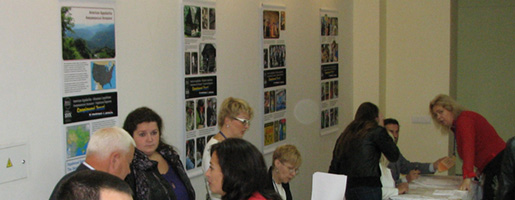
Christopher Miller prepared the bilingual Ukrainian/English exhibition, “Kindred Lands – Споріднені Землі,” in the form of six banners. It hung in the registration area.
September 25, 2013 – Conference Day 2 – Vasyl Stefanyk Precarpathian National University
The second day of the conference there were four concurrent sessions. The Americans’ presentations were interpreted in Ukrainian to the primarily Ukrainian audience. Interpreters sat with some Americans to attempt to help with Ukrainian and Polish papers, but the number of qualified interpreters was limited. Language differences continue to be a major obstacle to collaboration between Appalachian and Carpathian scholars. Qualified Ukrainian-English interpreters are rare in western Ukraine and very rare in the U.S.
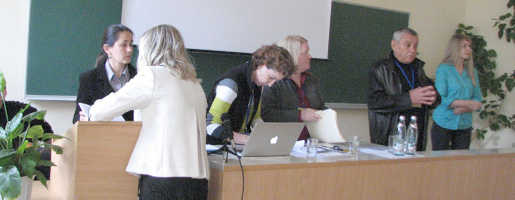
Katherine Ledford prepared to present “Reading the Landscape: Literary Representations of Coal Mining in Appalachia.” Michelle O’Malley prepares to present “Appalachia and the Carpathians: Comparing Highland Regions from a Cultural-linguistic Perspective.”
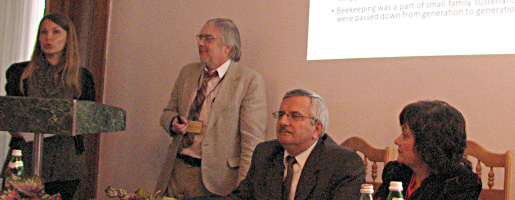
Paul Arnold presents “Beekeeping in Appalachia: Keeping the Craft Alive.”
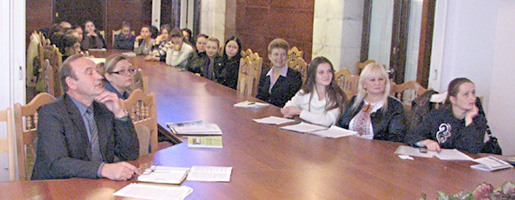
A crowded room enjoys Paul Arnold’s presentation.
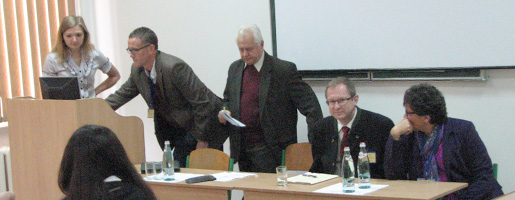
Geoff Buckley prepares to present “Moving Mountains in Appalachia: Life in the Shadow of MTR Mining.” Bernard Debatin prepares to present “Hydrofracking: Panacea or Pandemic?” Michele Morrone prepares to present “Scientific Uncertainty and the Public Debate about Hydraulic Fracturing.”

The session on hydraulic fracturing for natural gas in Appalachia, a process also known as fracking, was of great interest to some Ukrainians as there is an emerging possibility of the process being used in western Ukraine.
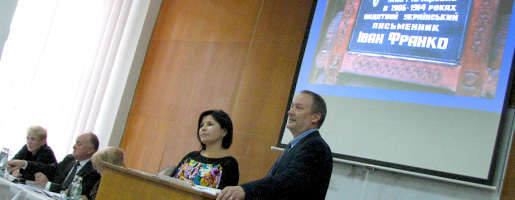
Ron Roach presenting “Place, Wilderness, and Education: Using Outdoor Education to Foster a Sense of Place in Mountain Regions.”
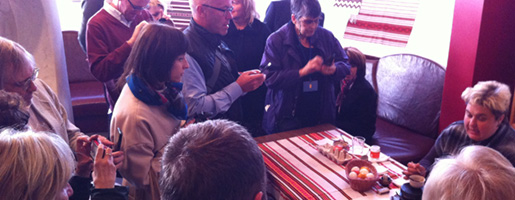
After the concurrent sessions, the delegation visited the City of Kolomyya, on the edge of the mountains, and the world famous Pysnky [Ukrainian Easter Egg] Museum. A master demonstrated the decoration of eggs using wax, heat, and dye. She also showed the technique for opening decorated eggs, removing the insides to preserve them, and painstakingly putting them back together.
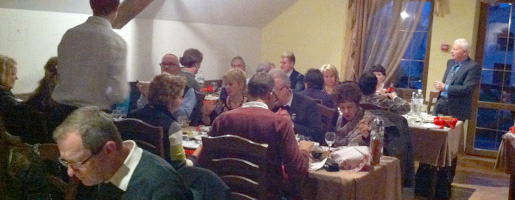
The closing dinner in Kolomyya was a grand affair with many toasts and words of appreciation.
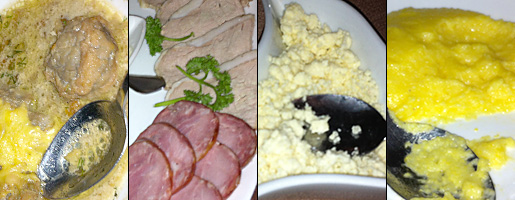
At the closing dinner in Kolomyya, we were served many foods tied to the Carpathians: mushrooms, sausage, pork, bryndza (a farmers cheese), and banush (corn meal cooked with sour cream).
September 26, 2013 – Post-Conference Tour, Kryvopillya Area
Following the formal conference, the American delegation travelled to the Village of Krivopillya. Mountain school expert Vasyl Krusch arranged a tour focused on Carpathian mountain education. Precarpathian National University has a mountain school research institute (directed by Professor Krusch) and its Institute for Pedagogy focuses much energy on the special challenges of providing education in the Carpathians. Some of its programs are specifically designed to prepare new teachers for the challenges of mountain schools.
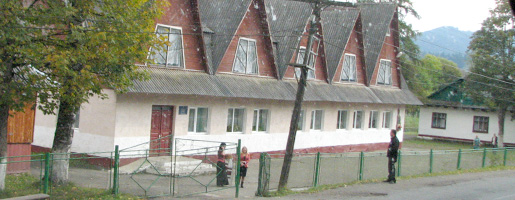
The Krivopillya Village secondary school, built in a style some call “Soviet Alpine.”
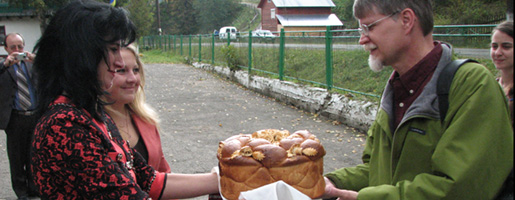
At the Krivopillya school for levels I-III, the school’s Director (Principal), Liliya Ivanivna Stephurak, received us warmly with the traditional ceremonial offering of bread.
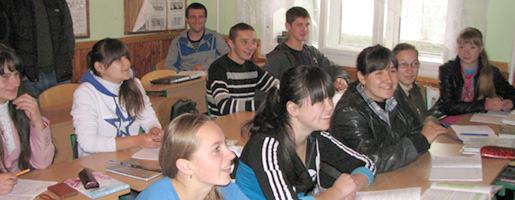
We toured two schools. These are high school level students at the Krivopillya village secondary school.
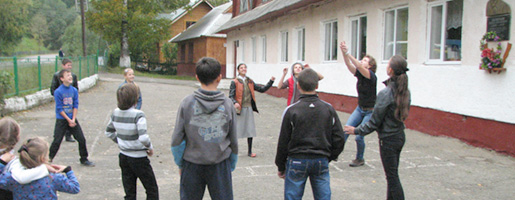
Students enjoyed our delegation’s volleyball and football (soccer) skills, or lack thereof.
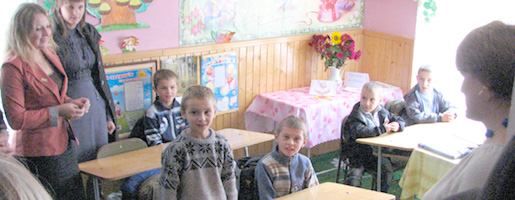
We also visited a satellite primary school of six students in the nearby Village of Volova.

An unplanned stop was perhaps the most unusual. We toured this beekeeping yard where bees are kept for their honey, wax, pollen, and curative properties. This small building was described as a “bee spa” in which people paid to sleep on beds over the bee hives for the curative properties of the micro-vibrations.
American Delegation:
- Paul T. Arnold, Ph.D. Professor and Chair of Biology, Young Harris College, Georgia
- Chris Baker, Ph.D. Professor of Sociology, Walters State Community College, Tennessee
- Chad Berry, PhD. Academic Vice President and Dean of the Faculty, Goode Professor of Appalachian Studies, and Professor of History, Berea College, Kentucky
- Lisa Berry, Honorary Delegate, Kentucky
- Geoffrey L. Buckley, Ph.D. Professor, Department of Geography and Program in Environmental Studies, Ohio University
- Judy P. Byers, PhD., Director, Frank and Jane Gabor West Virginia Folklife Center, Abelina Suarez Professor, Senior Level, English & Folklore Studies Fairmont State University, West Virginia
- Donald E. Davis, Ph.D. Independent Scholar, Washington D.C., Fulbright Scholar Precarpathian National University, Ukraine
- Bernhard Debatin, Ph.D. E. W. Scripps School of Journalism Professor of Journalism, Ohio University
- Rosann Kent, M.A., Director, Appalachian Studies Center, University of North Georgia
- Katherine Ledford, Ph.D. Center for Appalachian Studies, Appalachian State University, North Carolina
- Christopher A. Miller, M.A., Associate Director and Curator, Loyal Jones Appalachian Center, Berea College, Kentucky
- Michele Morrone, Ph.D. Associate Professor of Environmental Health Science, Department of Social and Public Health College of Health Sciences and Professions, Ohio University
- Michelle O’Malley, Ph.D. Assistant Professor of Linguistics, Department of Linguistics, Ohio University
- Ron R. Roach, Ph.D. Chair and Professor, Department of Appalachian Studies, East Tennessee State University
- Lynette D. Swiger, M.A. Adjunct Instructor, Central Appalachia/West Virginia Folk Music Hammered Dulcimer Specialist/Master, Dulcimer Artist, Elementary Educator/Reading Specialist Marion County Schools, Frank and Jane Gabor West Virginia Folklife Center on the campus of Fairmont State University and Pierpont Community & Technical College, West Virginia
- Noel W. Tenney, Folk Cultural Specialist Frank and Jane Gabor West Virginia Folklife Center, Museum Studies Program Coordinator Pierpont Community & Technical College, West Virginia
- Jessica Murray, Undergraduate Student, North Georgia University
Links:
- Video: Local television coverage of the Conference on 24 Channel in western Ukraine, including a clip of Lynette Swiger’s musical number and an interview with Christopher Miller. (Video is in Ukrainian)
- Article on Jessica Murray in the University of North Georgia Newsletter.
- Article on the Ohio contingent in the Ohio University College of Arts and Sciences Forum.
- Web Article at the Ohio contingent at the Ohio University Scripps College of Communication
- The Carpathian-Appalchian Conference Facebook page
Notes and Credits:
Christopher Miller prepared and edited this conference report. It reflects the observations and perspective of Miller and is not intended to reflect the positions or ideas any other participants, Berea College, PNU, or the Fulbright Program.
All photographs by C. Miller (except the formal group photo of all conference participants). All rights reserved 2013-14.o.